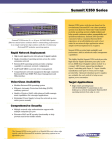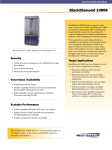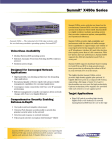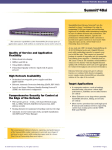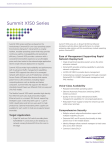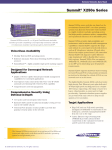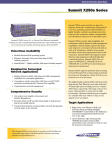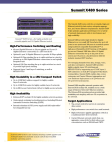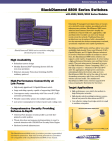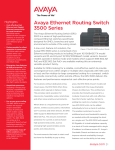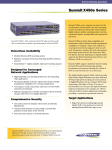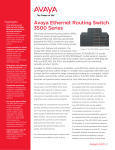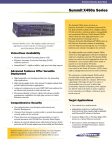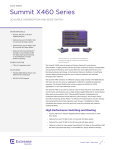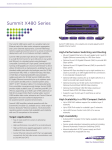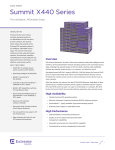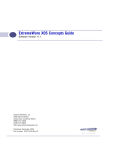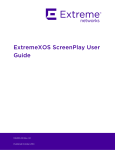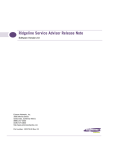Download Extreme networks Summit X150-48t
Transcript
Extreme Networks Data Sheet Summit® X150 Series Summit X150 series 24- or 48-port 10/100 Fast Ethernet stand-alone switches deliver outstanding performance in a simple enterprise edge solution with the revolutionary modular operating system, ExtremeXOS™. Ease of Management Supporting Rapid Network Deployment • Single streamlined operating system across the entire enterprise network • ExtremeXOS provides scripting capability to automate network configuration • LLDP/LLDP-MED to provide device management • Comprehensive network management through consistent ExtremeXOS CLI, SNMP, Web-based management and XML interface Summit X150 series switches are based on the revolutionary ExtremeXOS core-class operating system from Extreme Networks®. ExtremeXOS is a highly resilient, modular operating system that helps provide continuous uptime, manageability and operational efficiency. Summit X150 provides customers with a consistent ExtremeXOS experience at an affordable price and best suite in the network edge application where simple network deployment is required. Summit X150 provides high availability and performance with its advanced traffic management capabilities. Summit X150 supports the rollout of a converged network with devices such as IP telephones, wireless Access Points (APs) and other devices that require power from a LAN connection, including regular computing devices such as desktop and laptop computers. Summit X150-24p supports the 802.3af standards-based Power over Ethernet (PoE) on every port of its PoE models. • Quality of Service (QoS) with advanced traffic management capabilities for converged applications The highly flexible Summit X150 switch provides high-density Fast Ethernet ports plus dual personality Gigabit Ethernet ports in a compact 1RU format, supporting intelligent Layer 2 switching with Layer 2 – Layer 4 traffic classification and QoS on every port for high productivity. Optional redundant power supplies are provided with each switch to help secure against power anomalies. • Redundant Power Supply to keep the network up even under power anomaly Target Application Voice-Class Availability • Modular ExtremeXOS operating system • Ethernet Automatic Protection Switching (EAPS) resiliency protocol Comprehensive Security Using Defense-in-Depth • Edge PoE and non-PoE switch providing basic 10/100BASE-T connectivity to the desktop in a network running ExtremeXOS from the core to the edge • Multiple network edge authentication support with multiple endpoints per port • Extensive MAC and IP security functionality to help prevent man-in-the-middle attacks • Network intrusion detection and response The Summit X150 series switch is a Fast Ethernet value edge switch with ExtremeXOS modular operating system at an affordable price. © 2007 Extreme Networks, Inc. All rights reserved. Summit X150 Series—Page 1 Extreme Networks Data Sheet Ease of Management Supporting Rapid Network Deployment Summit X150 switches running ExtremeXOS provide a consistent network operation across the network. Summit X150 provides a variety of methods in configuring and managing the switch for ease of management and for rapid network deployment. Single Streamlined Operating System in the Entire Enterprise Network Extreme Networks provides an ExtremeXOS-based Ethernet switching platform from edge, aggregation, to core of the enterprise network. Having one operating system significantly simplifies network deployment and operation, as well as ongoing maintenance, to reduce the total cost of ownership. Summit X150 running ExtremeXOS provides a consistent experience among other switches such as the BlackDiamond® modular chassis and provides an excellent user experience from edge to core of the network. Network Configuration Automation ExtremeXOS provides extensible scripting capability that allows users to create a customized series of commands and executables. Scripting can be used to add incremental configuration to the network infrastructure, such as a list of VLANs to be configured. This capability eases the roll-out of networks and reduces configuration errors. For example, using the scripting capabilities of system and user-defined environment variables and constructs, such as if/then and loops, allow automating regular management tasks and deployment configurations of QoS rate limiting and ACLs to multiple ports or multiple switches. Link Layer Discovery Protocol (LLDP) and LLDPMedia Endpoint Discovery (LLDP-MED) ExtremeXOS supports IEEE 802.1ab standards-based discovery protocol and provides vendor independent device discovery. It also provides tight integration with VoIP infrastructure and phones, including E911 ECS location, inventory information and fine grain PoE budgeting and configuration of information such as VLANs and QoS tagging. © 2007 Extreme Networks, Inc. All rights reserved. LLDP not only simplifies deployment and location of access devices, but can also be used as a troubleshooting and firmware management tool. LLDP is an extensible standard, providing a framework for industry consortiums to define application-specific extensions without causing compatibility issues. The ANSI/TIA-1057 LLDP-Media Endpoint Discovery (LLDP-MED) standard defines extensions specifically for VoIP. These extensions provide VoIP-specific information as well as allow transmission of configuration and location information to VoIP phones. Efficient Management to Handle Convergence-Driven Network Changes Power over Ethernet Deployments of IP Telephony depend on reliable consistent power from the Ethernet jack. Summit X150-24p is the basis for a reliable LAN Telephony infrastructure with fully redundant 15.4 watts per port, and QoS and resiliency to match the failover requirements for latency sensitive services like VoIP phones. With Summit X150, deployment of powered LAN devices is quick and easy with its support of the IEEE 802.3af standard and full Class 3 power availability on all ports, backed up 100% by the EPS-500 redundant power supply. Comprehensive Network Management As the network becomes a foundation of the enterprise application, network management becomes an important piece of the solution. Summit X150 supports comprehensive network management through Command Line Interface (CLI), SNMP v1, v2c, v3 and the embedded XML-based Web User Interface, ExtremeXOS™ ScreenPlay™. With a variety of management options and consistency across other Extreme Networks modular and fixed configuration switches, Summit X150 series switches provide ease of management for demanding converged applications. Extreme Networks has developed tools that help save you time and resources in managing your network. EPICenter® provides fault configuration, accounting, performance and security functions, allowing more effective management of Extreme Networks multilayer switching equipment in a converged network. Voice Grade Connections Granular QoS, low latency and low jitter provide voice quality connections. Summit X150 supports a range of QoS technologies that can prioritize and predictably handle high priority traffic policing or rate limiting on ingress, 802.1Q tagging and Diffserv marking, and shaping on egress with eight queues per port. The Extreme Networks tradition of building products with low latency and jitter continues with the Summit X150 series—allowing network managers to build their networks with low end-to-end latency and jitter. Summit X150 Series—Page 2 Extreme Networks Data Sheet Voice-Class Availability Powered by ExtremeXOS, the Summit X150 switch supports process recovery and application upgrades without the need for a system reboot. Summit X150 offers the high network availability required for converged applications. Modular Operating System to Help Maximize Uptime True Preemptive Multitasking and Protected Memory Summit X150 switches allow each of the many applications—such as Spanning Tree Protocol (STP)—to run as separate operating system processes that are protected from each other. This drives increased system integrity and helps protect against Denial of Service (DoS) attacks. Process Monitoring and Restart ExtremeXOS improves network availability using process monitoring and restart. Each independent operating system process is monitored in real time. If a process becomes unresponsive or stops running, it can be automatically restarted. Loadable Software Modules The modular design of ExtremeXOS allows the upgrading of individual software modules, should this be necessary, leading to higher availability in the network (see Figure 1). High Availability Network Protocols Ethernet Automatic Protection Switching (EAPS) EAPS allows the IP network to provide the level of resiliency and uptime that users expect from their traditional voice network. EAPS differs from Spanning Tree and Rapid Spanning Tree protocols offering sub-second (less than 50 milliseconds) recovery that helps deliver consistent failover regardless of the number of VLANs, network nodes or network topology. Since EAPS allows the network to recover almost transparently, VoIP calls do not drop and digital video feeds do not freeze or pixelize in most situations. Spanning Tree/Rapid Spanning Tree Protocols Summit X150 switches support Spanning Tree (802.1D), Per VLAN Spanning Tree (PVST+), Rapid Spanning Tree (802.1w) and Multiple Instances of Spanning Tree (802.1s) protocols for Layer 2 resiliency. © 2007 Extreme Networks, Inc. All rights reserved. Link Aggregation (802.3ad) Link aggregation allows trunking of up to eight links on a single logical connection, for up to 2 Gigabits per Second (Gbps) of redundant bandwidth per logical connection. Exceptional Policy-based QoS with Advanced Traffic Management for Converged Applications Summit X150 provides eight hardware queues per port to support granular traffic classification with bandwidth allocation. The 1,024 centralized classifiers per 24-port block can use information from Layers 1 through 4 to prioritize and meter incoming packets at line-rate. When metering traffic, the switches can drop out-of-spec traffic or flag it for later action. To expedite upstream traffic handling, a packet’s classification can be carried forward with Layer 2 (802.1p) and Layer 3 (Diffserv) markings. Summit X150 switches provide advanced traffic management features that offer high-quality triple play of voice, video and data services. Redundant Power Supplies Summit X150 switches provide external redundant power supply and offers a convenient and easy to upgrade in-field option to protect against power anomalies. Configuration Management (CLI/SNMP/XML/Scripts) ExtremeXOS Application Modules sFlow Network Login 802.1x SSH2 SCP2 SFTP STP EAPS LLDP ExtremeXOS Kernel-Loadable Modules ExtremeXOS Kernel Hardware Abstraction Layer Hardware 5171-01 Figure 1: ExtremeXOS Modular Design Summit X150 Series—Page 3 Extreme Networks Data Sheet Comprehensive Security Using Defense-in-Depth Implementing a secure network means providing protection at the network perimeter as well as the core. Working together with the Sentriant™ family of products from Extreme Networks, Summit X150 series switches use a defense-in-depth strategy to help protect your network from known or potential threats. Security offerings from Extreme Networks encompass three key areas: user and host integrity, threat detection and response, and hardened network infrastructure. User Authentication and Host Integrity Checking Network Login Network Login capability enforces user admission and usage policies. Summit X150 series switches support a comprehensive range of Network Login options by providing an 802.1x agent-based approach, a web-based (agent-less) login capability for guests, and a MAC-based authentication model for devices. With these modes of Network Login, only authorized users and devices are permitted to connect to the network and be assigned to the appropriate VLAN. Multiple Supplicant Support Shared ports represent a potential vulnerability in a network. Multiple supplicant capability on a switch allows it to uniquely authenticate and apply the appropriate policies and VLANs for each user or device on a shared port. model from the Trusted Computing Group. Summit X150 interfaces with Sentriant AG endpoint security software from Extreme Networks to verify that each endpoint meets the security policies that have been set, and quarantines those that are not in compliance. Extensive MAC and IP Security Functionality MAC Security MAC security allows the lock down of a port to a given MAC address and to limit the number of MAC addresses on a port. This can be used to dedicate ports to specific hosts or devices such as VoIP phones or printers and avoid abuse of the port—an interesting capability specifically in environments such as hotels. In addition, an aging timer can be configured for the MAC lockdown, protecting the network from the effects of attacks using (often rapidly) changing MAC addresses. IP Security ExtremeXOS IP Security Framework helps protect the network infrastructure, network services such as DHCP and DNS and host computers from spoofing and man-in-the middle attacks. It also helps protect the network from statically configured and/or Host Integrity Checking Host integrity checking helps keep infected spoofed IP addresses and builds an external trusted database of MAC/IP/port bindings or non-compliant machines off the providing the traffic’s source from a specific network. Summit X150 series switches address for immediate defense. support a host integrity or endpoint integrity solution that is based on the Multiple supplicant support helps secure IP Telephony and wireless access. Converged network designs often involve the use of shared ports (see Figure 2). Network Intrusion Detection and Response Hardware-Based sFlow Sampling sFlow is a sampling technology that provides the ability to continuously monitor application level traffic flows on all interfaces simultaneously. The sFlow agent is a software process that runs on Summit X150 switches and packages data into sFlow datagrams that are sent over the network to an sFlow collector. The collector gives an up-to-the minute view of traffic across the entire network, providing the ability to troubleshoot network problems, control congestion and detect network security threats. Port Mirroring To allow threat detection and prevention, Summit X150 switches support many-toone and one-to-many port mirroring. This allows the mirroring of traffic to an external network appliance such as an intrusion detection device for trend analysis or for utilization by a network administrator for diagnostic purposes. Line-Rate ACLs ACLs are one of the most powerful components used in controlling network resource utilization as well as protecting the network. Summit X150 switches support 1,024 centralized ACLs per 24-port based on Layer 2, 3 or 4-header information such as the MAC, IPv4 and IPv6 address or TCP/UDP port. Denial of Service Protection Summit X150 offers Multiple Supplicant which helps provide the per MAC based authentication with dynamic VLAN allocation Summit X150 can effectively handle DoS attacks. If the switch detects an unusually large number of packets in the CPU input queue, it will assemble ACLs that automatically stop these packets from reaching the CPU. After a period of time, these ACLs are removed, and reinstalled if the attack continues. Secure Management ` ` VLAN Green ` ` ` VLAN Orange ` ` VLAN Purple ` ` To prevent management data from being intercepted or altered by unauthorized access, Summit X150 supports SSH2, SCP and SNMPv3 protocols. Rogue Clients 5155-01 Figure 2: Multiple Supplicant Support © 2007 Extreme Networks, Inc. All rights reserved. Summit X150 Series—Page 4 Extreme Networks Data Sheet Target Applications Edge Connectivity for Advanced Applications NETWORK CORE • Edge PoE and non-PoE switch providing intelligent 10/100BASE-T connectivity to the desktop in a network running ExtremeXOS from the core to the edge Summit X150 is deployed as an intelligent Fast Ethernet edge switch, extending the benefits of the ExtremeXOS operating system to the network edge. This uniformity allows consistent quality and performance throughout your converged network while minimizing operational inefficiencies. With low latency and line-rate performance, the Summit X150 edge switch connects wireless devices, LAN Telephony, PDAs and other equipment without compromising security, scalability, availability, mobility or management. © 2007 Extreme Networks, Inc. All rights reserved. Summit X150 Summit X150 ` ` 5156-01 Summit X150 Series—Page 5 Extreme Networks Data Sheet Technical Specifications ExtremeXOS V12.0 Supported Protocols Switching • RFC 9 Ethernet Automatic Protection Switching (EAPS) and EAPSv2 • IEEE 802.1D – 1998 Spanning Tree Protocol (STP) • IEEE 802.1D – 2004 Spanning Tree Protocol (STP and RSTP) • IEEE 802.1w – 2001 Rapid Reconfiguration for STP, RSTP • IEEE 802.1Q-2003 (formerly IEEE 802. s) Multiple Instances of STP, MSTP • EMISTP, Extreme Multiple Instances of Spanning Tree Protocol • PVST+, Per VLAN STP (802. Q interoperable) • IEEE 802.1Q – 998 Virtual Bridged Local Area Networks • IEEE 802.3ad Static load sharing configuration and LACP based dynamic configuration • IEEE 802.1AB – LLDP Link Layer Discovery Protocol • LLDP Media Endpoint Discovery (LLDP-MED), ANSI/TIA-1057, draft 08 • Extreme Discovery Protocol (EDP) • Extreme Loop Recovery Protocol (ELRP) • Extreme Link State Monitoring (ELSM) • Software Redundant Ports VLANs, vMANs • IEEE 802.1Q VLAN Tagging • IEEE 802.1v: VLAN classification by Protocol and Port • Port-based VLANs • Protocol-based VLANs • Multiple STP domains per VLAN • IEEE 802.1ad Virtual MANs (vMANs) Quality of Service and Policies • IEEE 802.1D – 998 (802. p) Packet Priority • RFC 2474 DiffServ Precedence, including 8 queues/port • RFC 2598 DiffServ Expedited Forwarding (EF) • RFC 2597 DiffServ Assured Forwarding (AF) IPv4 • RFC 1519 CIDR • RFC 1122 Host Requirements • RFC 768 UDP • RFC 791 IP • RFC 792 ICMP • RFC 793 TCP • RFC 826 ARP • RFC 894 IP over Ethernet • RFC 1027 Proxy ARP • RFC 2068 HTTP server – Used for web-based Network Login • RFC 1112 IGMP v1 • RFC 2236 IGMP v2 • RFC 3376 IGMP v3 • IGMP v1/v2/v3 Snooping • IGMP Filters • Static IGMP Membership • Multicast VLAN Registration IPv6 • RFC 2460, Internet Protocol, Version (IPv6) Specification • RFC 2461, Neighbor Discovery for IP Version 6, (IPv6) • RFC 2462, IPv6 Stateless Address Auto configuration • RFC 2463, Internet Control Message Protocol (ICMPv6) for the IPv6 Specification • RFC 2464, Transmission of IPv6 Packets over Ethernet Networks © 2007 Extreme Networks, Inc. All rights reserved. •RFC 2465, IPv6 MIB, General Group and Textual Conventions •RFC 2466, MIB for ICMPv6 •RFC 1981, Path MTU Discovery for IPv6, August 1996 •RFC 3513, Internet Protocol Version 6 (IPv6) Addressing Architecture •RFC 3587, Global Unicast Address Format •RFC 2710, IPv6 Multicast Listener Discovery v1 (MLDv1 ) Protocol •RFC 3810, IPv6 Multicast Listener Discovery v2 (MLDv2) Protocol •Telnet server over IPv6 transport •SSH-2 server over IPv6 transport •Ping over IPv6 transport •Traceroute over IPv6 transport Management and Traffic Analysis •RFC 2030 SNTP, Simple Network Time Protocol v4 •RFC 854 Telnet client and server •RFC 783 TFTP Protocol (revision 2) •RFC 951, 1542 BootP •RFC 2131 BOOTP/DHCP relay agent and DHCP ser ver •RFC 1591 DNS (client operation) •RFC 1155 Structure of Mgmt Information (SMIv1) •RFC 1157 SNMPv1 •RFC 1212, RFC 1213, RFC 1215 MIB-II, EthernetLike MIB & TRAPs •RFC 1573 Evolution of Interface •RFC 1650 Ethernet-Like MIB (update of RFC 1213 for SNMPv2) •RFC 1901 – 1908 SNMP v2c, SMIv2 and Revised MIB-II •RFC 2570 – 2575 SNMPv3, user based security, encryption and authentication •RFC 2576 Coexistence between SNMP Version 1, Version 2 and Version 3 •RFC 1757 RMON 4 groups: Stats, History, Alarms and Events •RFC 2021 RMON2 (probe configuration) •RFC 2668 802.3 MAU MIB •RFC 1643 Ethernet MIB •RFC 1493 Bridge MIB •RFC 1354 IPv4 Forwarding Table MIB •RFC 2737 Entity MIB v2 •RFC 2233 Interface MIB •RFC 1354 IP Forwarding Table MIB •Draft-ietf-bridge-rstpmib-03.txt – Definitions of Managed Objects for Bridges with Rapid Spanning Tree Protocol •Secure Shell (SSH-2) client and server •Secure Copy (SCP-2) client and server •Secure FTP (SFTP) server •sFlow version 5 •Configuration logging •Multiple Images, Multiple Configs •BSD System Logging Protocol (SYSLOG), with Multiple Syslog Servers ––999 Local Messages (criticals stored across reboots) •Extreme Networks vendor MIBs (includes FDB, PoE, CPU, Memory MIBs) •Web-based device management interface Security •Secure Shell (SSH-2), Secure Copy (SCP-2) and SFTP client/server with encryption/authentication (requires export controlled encryption module) •SNMPv3 user based security, with encryption/ authentication (see above) •RFC 1492 TACACS+ • RFC 2138 RADIUS Authentication • RFC 2139 RADIUS Accounting • RFC 3579 RADIUS EAP support for 802.1x • RADIUS Per-command Authentication • Access Policies for Telnet/SSH-2/SCP-2 • Network Login - 802.1x, web and MAC-based mechanisms • IEEE 802.1x – 2001 Port-Based Network Access Control for Network Login • Multiple supplicants with multiple VLANs for Network Login (all modes) • Fallback to local authentication database (MAC and Web-based methods) • Guest VLAN for 802.1x • RFC 1866 HTML – Used for web-based Network Login • SSL/TLS transport – used for for web-based Network Login, (requires export controlled encryption module) • MAC Security – Lockdown and Limit • IP Security – RFC 3046 DHCP Option 82 with port and VLAN ID • IP Security – Source IP Lockdown • IP Security – Trusted DHCP Server • Layer 2/3/4 Access Control Lists (ACLs) Denial of Service Protection: • RFC 2267 Network Ingress Filtering • Wire-speed ACLs • Rate Limiting / Shaping by ACLs • IP Broadcast Forwarding Control • ICMP and IP-Option Response Control • SYN attack protection • CPU DoS Protection with traffic rate-limiting to management CPU • Robust against common Network Attacks: ––CERT (http://www.cert.org) ––CA-2003-04: “SQL Slammer” ––CA-2002-36: “SSHredder” ––CA-2002-03: SNMP vulnerabilities ––CA-98-13: tcp-denial-of-service ––CA-98.01: smurf ––CA-97.28:Teardrop_Land -Teardrop and “LAND“ attack ––CA-96.26: ping ––CA-96.21: tcp_syn_flooding ––CA-96.01: UDP_service_denial ––CA-95.01: IP_Spoofing_Attacks_and_ Hijacked_ Terminal_Connections ––IP Options Attack • Host Attacks ––Teardrop, boink, opentear, jolt2, newtear, nestea, syndrop, smurf, fraggle, papasmurf, synk4, raped, winfreeze, ping –f, ping of death, pepsi5, Latierra, Winnuke, Simping, Sping, Ascend, Stream, Land, Octopus Summit X150-24t General Specifications Performance • 8.8 Gbps switch fabric bandwidth • 6.5 Mpps frame forwarding rate • 9,216 Byte maximum packet size (Jumbo Frame) • 13 load sharing trunks, up to 8 members per trunk • 8 QoS queues/port • 4,094 VLANs (Port, Protocol, IEEE 802.1Q) • 1,024 centralized ACL rules per switch Summit X150 Series—Page 6 Extreme Networks Data Sheet Technical Specifications Forwarding Tables •Layer 2/MAC Addresses: 8K Rate Limiting •Ingress bandwidth policing/rate limiting per flow •Egress bandwidth rate limiting per egress queue •Rate Limiting Granularity: 64Kbps •Available Rate Limiters: 1,024 per switch Indicators •Per port status LED •System Status LEDs: management, fan and power Ports •24 ports 10/100BASE-T with auto-speed and auto-polarity •2 ports Gigabit Ethernet (SFP mini-GBIC, shared PHY with 2 10/100/1000BASE-T ports) •1 port Serial (control port) •1 10/100BASE-T out-of-band management port Physical Specifications Dimensions and Weight Height: 1.73 Inches/4.4 Cm Width: 17.35 Inches/44.1 Cm Depth: 12.13 Inches/30.8 Cm Weight: 10.47 Lbs/4.76 Kg EPS Dimensions and Weight EPS-T Height: 1.75 Inches/4.4 Cm Width: 17.4 Inches/44 Cm Depth: 7.6 Inches/19.3 Cm EPS-160 Height: 1.7 Inches/4.3 Cm Width: 7.4 Inches/18.8 Cm Depth: 7.9 Inches/20 Cm Operating Specifications Temperature •Operating Temperature Range: 0° C to 40° C (32° F to 104° F) •Operating Humidity: 10% to 93% relative humidity, non-condensing •Operational Shock (Half Sine): 30 m/s2 (3g), 11ms, 60 Shocks •Operational Random Vibration: 5 – 500 Hz @ 1.5g rms Storage & Transportation Conditions (Packaged) •Transportation Temperature: -40° C to 70° C (- 40° F to 158° F) •Storage and Transportation Humidity: 60% to 95% RH, non-condensing •Packaged Shock (Half Sine): 180 m/s2 (18g), 6ms, 600 shocks •Packaged Sine Vibration: 5 – 62 Hz @ Velocity 5mm/s, 62 – 500 Hz @ 0.2 G •Packaged Random Vibration: 5 – 20 Hz @ 1.0 ASD w/-3dB/oct. from 20 – 200 Hz •14 drops min on sides & corners @ 42”(<15kg box) Power & Acoustic Sound •Voltage Input Range: 90 – 264V Nominal Input Ratings: 100 – 240V~, 50/60 Hz, 1.0A •Input Current: 0.5A @ 115V~ (lowline) 0.25A @ 230V~ (high-line) •Maximum In-Rush Current: 30A @115V/60 Hz, Max Load •Efficiency: 83% with 60% – 100% load •Line Frequency Range: 47 – 63 Hz •Power Supply Input Socket: IEC 320 C14 •Power Cord Input Plug: IEC 320 C13 •Heat Dissipation: 36W (123 BTU/h) •Power Consumption: 36W (123 BTU/h) © 2007 Extreme Networks, Inc. All rights reserved. •Acoustic Noise (Low FAN Speed): 37 dBA per ISO 7779 •Acoustic Noise (High FAN Speed): 45 dBA per ISO 7779 External Power Supply - EPS-160 •Voltage Input Range: 90 – 264V •Nominal Input Ratings: 100 – 240V~, 50 – 60 Hz, 4A •Line Frequency Range: 47 – 63 Hz •Maximum Input Current: 2A at 115 VAC, 1A at 230 VAC •Maximum Inrush Current: 30A at 115 VAC, 60A at 230 VAC •Power Supply Input Socket: IEC 320 C14 •Power Cord Input Plug: IEC 320 C13 •Heat Dissipation: 38.5W (131.4 BTU/h) •Power Consumption: 178W (607.4 BTU/h) Summit X150-48t General Specifications Performance •13.6 Gbps switch fabric bandwidth •10.1 Mpps frame forwarding rate •9,216 Byte maximum packet size (Jumbo Frame) •25 load sharing trunks, up to 8 members per trunk •8 QoS queues/port •4,094 VLANs (Port, Protocol, IEEE 802.1Q) •1,024 centralized ACL rules per 24-port Forwarding Tables •Layer 2/MAC Addresses: 8K Rate Limiting •Ingress bandwidth policing/rate limiting per flow •Egress bandwidth rate limiting per egress queue •Rate Limiting Granularity: 64Kbps •Available Rate Limiters: 1,024 per switch Indicators •Per port status LED including power status •System Status LEDs: management, fan and power Ports •48 ports 10/100BASE-T with auto-speed and auto-polarity •2 ports Gigabit Ethernet (SFP mini-GBIC, shared PHY with 2 10/100/1000BASE-T ports) •1 port serial (console port) •1 10/100BASE-T out-of-band management port Physical Specifications Dimensions and Weight Height: 1.73 Inches/4.4 Cm Width: 17.35 Inches/44.1 Cm Depth: 15.28 Inches/38.8 Cm Weight: 12.06 lbs/5.48 Kg EPS Dimensions and Weight EPS-T Height: 1.75 Inches/4.4 Cm Width: 17.4 Inches/44 Cm Depth: 7.6 Inches/19.3 Cm EPS-160 Height: 1.7 Inches/4.3 Cm Width: 7.4 Inches/18.8 Cm Depth: 7.9 Inches/20 Cm Operating Specifications Temperature •Operating Temperature Range: 0° C to 40° C (32° F to 104° F) •Operating Humidity: 10% to 93% relative humidity, non-condensing • Operational Shock (Half Sine): 30 m/s2 (3g), 11ms, 60 Shocks • Operational Random Vibration: 5 – 500 Hz @ 1.5g rms Storage & Transportation Conditions (Packaged) • Transportation Temperature: -40° C to 70° C (- 40° F to 158° F) • Storage and Transportation Humidity: 60% to 95% RH, non-condensing • Packaged Shock (Half Sine): 180 m/s2 (18g), 6ms, 600 shocks • Packaged Sine Vibration: 5 – 62 Hz @ Velocity 5mm/s, 62 – 500 Hz @ 0.2 G • Packaged Random Vibration: 5 – 20 Hz @ 1.0 ASD w/-3dB/oct. from 20 – 200 Hz • 14 drops min on sides & corners @ 42” (<15kg box) Power & Accoustic Sound • Voltage Input Range: 90 – 264V • Nominal Input Ratings: 100 – 240V~, 50/60 Hz, 1.0A • Input Current: 0.6A @ 115V~ (lowline) 0.3A @ 230V~ (high-line) • Maximum In-Rush Current: 30A @115V/60 Hz, Max Load • Efficiency: 83% with 60% – 100% load • Line Frequency Range: 47 – 63 Hz • Power Supply Input Socket: IEC 320 C14 • Power Cord Input Plug: IEC 320 C13 • Heat Dissipation: 51W (174 BTU/h) • Power Consumption: 51W (174 BTU/h) • Acoustic Noise (Low FAN Speed): 37 dBA per ISO 7779 • Acoustic Noise (High FAN Speed): 47 dBA per ISO 7779 External Power Supply - EPS-160 • Voltage Input Range: 90 – 264V • Nominal Input Ratings: 100 – 240V~, 50 – 60 Hz, 4A • Line Frequency Range: 47 – 63 Hz • Maximum Input Current: 2A at 115 VAC, 1A at 230 VAC • Maximum Inrush Current: 30A at 115 VAC, 60A at 230 VAC • Power Supply Input Socket: IEC 320 C14 • Power Cord Input Plug: IEC 320 C13 • Heat Dissipation: 38.5W (131.4 BTU/h) • Power Consumption: 178W (607.4 BTU/h) Summit X150-24p General Specifications Performance • 8.8 Gbps switch fabric bandwidth • 6.5 Mpps frame forwarding rate • 9,216 Byte maximum packet size (Jumbo Frame) • 13 load sharing trunks, up to 8 members per trunk • 8 QoS queues/port • 4,094 VLANs (Port, Protocol, IEEE 802.1Q) • 1,024 centralized ACL rules per switch Forwarding Tables • Layer 2/MAC Addresses: 8K Rate Limiting • Ingress bandwidth policing/rate limiting per flow • Egress bandwidth rate limiting per egress queue • Rate Limiting Granularity: 64Kbps • Available Rate Limiters: 1,024 per switch Indicators • Per port status LED including power status • System Status LEDs: management, fan and power Summit X150 Series—Page 7 Extreme Networks Data Sheet Technical Specifications Ports • 24 ports 10/100BASE-T PoE with auto-speed and auto-polarity • 2 ports Gigabit Ethernet (SFP mini-GBIC, shared PHY with 2 10/100/1000BASE-T ports) • 1 port serial (console port) • 1 10/100BASE-T out-of-band management port Physical Specifications Dimensions and Weight Height: 1.73 Inches/4.4 Cm Width: 17.35 Inches/44.1 Cm Depth: 12.13 Inches/30.8 Cm Weight: 12.1 Lbs/5.46 Kg EPS Dimensions and Weight EPS-500 Height: 1.73 Inches/4.4 Cm Width: 17.4 Inches/44 Cm Depth: 7.6 Inches/19.3 Cm Weight: 10.8 Lbs/4.9 Kg Operating Specifications Temperature • Operating Temperature Range: 0° C to 40° C (32° F to 104° F) • Operating Humidity: 10% to 93% relative humidity, non-condensing • Operational Shock (Half Sine): 30 m/s2 (3g), 11ms, 60 Shocks • Operational Random Vibration: 5 – 500 Hz @ 1.5g rms Storage & Transportation Conditions (Packaged) • Transportation Temperature: -40° C to 70° C (- 40° F to 158° F) • Storage and Transportation Humidity: 60% to 95% RH, non-condensing • Packaged Shock (Half Sine): 180 m/s2 (18g), 6ms, 600 shocks • Packaged Sine Vibration: 5 – 62 Hz @ Velocity 5mm/s, 62 – 500 Hz @ 0.2 G • Packaged Random Vibration: 5 – 20 Hz @ 1.0 ASD w/-3dB/oct. from 20 – 200 Hz • 14 drops min on sides & corners @ 42” (<15kg box) Power & Acoustic Sound • Voltage Input Range: 90 – 264V • Nominal Input Ratings: 100 – 240V~, 50/60 Hz, 5.5A • Input Current (with PoE full load): 4.4A @ 115V~ (lowline) 2.2A @ 230V~ (high-line) • Input Current (without PoE): 0.75A @ 115V~ (lowline) 0.5A @ 230V~ (high-line) • Maximum In-Rush Current: 30A @115V/60 Hz, Max Load • Efficiency: 81% with 60% – 100% load • Line Frequency Range: 47 – 63 Hz • Nominal Frequency Range: 50 – 60 Hz • Power Supply Input Socket: IEC 320 C14 • Power Cord Input Plug: IEC 320 C13 • Heat Dissipation (with PoE full load): 100W (341BTU/h) • Power Consumption (with PoE full load): 470W (1604 BTU/h) • Heat Dissipation (without PoE): 55W (188 BTU/h) • Power Consumption (without PoE): 55W (188 BTU/h) • Acoustic Noise (Low FAN Speed): 39 dBA per ISO 7779 • Acoustic Noise (High FAN Speed): 44 dBA per ISO 7779 © 2007 Extreme Networks, Inc. All rights reserved. External Power Supply – EPS-500 • Voltage Input Range: 90 – 264V • Nominal Input Ratings: 100 – 240V~, 50 – 60 Hz, 10A • Line Frequency Range: 47 – 63 Hz • Maximum Input Current: 5.75A at 115 VAC, 2.80A at 230 VAC • Maximum Inrush Current: 30A at 115 VAC, 60A at 230 VAC • Output: -50 VDC, 7.5A max, 375 Watts 12 VDC, 7.5A max, 90 Watts • Power Supply Input Socket: IEC 320 C14 • Power Cord Input Plug: IEC 320 C13 • Heat Dissipation: 125W (427 BTU/h) • Power Consumption: 625W (2,133 BTU/h) Summit X150 Series Regulatory/Safety Standards North American Safety of ITE • UL 60950-1:2003 1st Ed., Listed Device (U.S.) • CSA 22.2#60950-1-03 1st Ed.(Canada) • Complies with FCC 21CFR 1040.10 (U.S. Laser Safety) • CDRH Letter of Approval (U.S. FDA Approval) • IEEE 802.3af 6-2003 Environment A for PoE Applications European Safety of ITE • EN 60950-1+A11:2001 TUV-R GS Mark by German Notified Body • EN 60825-1+A2:2001 (Lasers Safety) • 73/23/EEC Low Voltage Directive • International Safety of ITE • CB Report & Certificate per IEC 609501:2001+All Country Deviations • AS/NZS 60950-1 (Australia /New Zealand) EMI/EMC Standards North America EMC for ITE • FCC CFR 47 part 15 Class A (U.S.A.) • ICES-003 Class A (Canada) European EMC standards • EN 55022+A2:2003 Class A • EN 55024+A2:2003 Class A includes IEC 61000-4- 2, 3, 4, 5, 6, 11 • EN 61000-3-2,3 (Harmonics & Flicker) • ETSI EN 300 386:2001 (EMC Telecommunications) • 89/336/EEC EMC Directive International EMC Certifications • CISPR 22:1997 Class A (International Emissions) • CISPR 24:1997 Class A (International Immunity) • IEC/EN 61000-4-2 Electrostatic Discharge, 8kV Contact, 15kV Air, Criteria A • IEC/EN 61000-4-3 Radiated Immunity 10V/m, Criteria A • IEC/EN 61000-4-4 Transient Burst, 1kV, Criteria A • IEC/EN 61000-4-5 Surge, 2kV L-L, 2kV L-G, Level 3, Criteria A • IEC/EN 61000-4-6 Conducted Immunity, 0.15 – 80MHz, 10V/m unmod. RMS, Criteria A • IEC/EN 61000-4-11 Power Dips & Interruptions, >30%, 25 periods, Criteria C Country Specific • VCCI Class A (Japan Emissions) • AS/NZS 3548 ACA (Australia Emissions) • CNS 13438:1997 Class A (BSMI-Taiwan) • MIC Mark, EMC Approval (Korea) Telecom Standards • ETSI EN 300 386:2001 (EMC Telecommunications) • ETSI EN 300 019 (Environmental for Telecommunications) • IEEE 802.3 Media Access Standards • IEEE 802.3ab 1000BASE-T • IEEE 802.3z 1000BASE-X Environmental Standards • EN/ETSI 300 019-2-1 v2.1.2 – Class 1.2 Storage • EN/ETSI 300 019-2-2 v2.1.2 – Class 2.3 Transportation • EN/ETSI 300 019-2-3 v2.2.2 – Class 3.1e Operational • EN/ETSI 300 753 (1997-10) – Acoustic Noise ASTM D3580 Random Vibration Unpackaged 1.5G Warranty • Limited Lifetime Hardware Warranty • 90-days on Software Summit X150 Series—Page 8 Extreme Networks Data Sheet Accessories Summit X150 Series Redundant PSUs EPS-160 and EPS-T EPS-160 is the redundant AC Power Supply for lower power consuming AC PSU-based Summit switches. When installing it, EPS-T power tray is required to rack mount this external power supply. EPS-T power tray can take up to two EPS-160 power modules, and each EPS-160 works individually. EPS-160 comes with DC output cable to connect between the Summit switch and EPS-160. Front View EPS-500 EPS-500 is the redundant AC Power Supply for higher power consuming AC PSU based switches including Power-over-Ethernet enabled switches. EPS-500 is one rack unit height and works in standalone. EPS-500 can be rack mounted in a regular 19 inch rack system. EPS-500 comes with a DC output cable to connect between the Summit switch and EPS-500. Front View Rear View Redundant PSU Compatibility Matrix Summit Switch Models Summit Switch Part Number(s) External Redundant PSU options Summit X150-24t 15201 EPS-160 power module (10907) with EPS-T (10906) Summit X150-48t 15203 EPS-160 power module (10907) with EPS-T (10906) Summit X150-24p 15205 EPS-500 external power supply (10911) © 2007 Extreme Networks, Inc. All rights reserved. Summit X150 Series—Page 9 Extreme Networks Data Sheet Ordering Information Part Number Name Description 15201 Summit X150-24t 24 10/100BASE-TX, 2 gigabit combo ports (2 unpopulated gigabit SFP and 10/100/1000BASE-T), ExtremeXOS Layer 2 Edge License, 1 AC PSU, connector for EPS-160 external redundant PSU 15203 Summit X150-48t 48 10/100BASE-TX, 2 gigabit combo ports (2 unpopulated gigabit SFP and 10/100/1000BASE-T), ExtremeXOS Layer 2 Edge License, 1 AC PSU, connector for EPS-160 external redundant PSU 15205 Summit X150-24p 24 10/100BASE-TX with PoE, 2 gigabit combo ports (2 unpopulated gigabit SFP and 10/100/1000BASE-T), ExtremeXOS Layer 2 Edge License, 1 AC PSU, connector for EPS-500 external redundant PSU 10906 EPS-T1 External Power System power tray. Accepts up to two EPS-160 power modules 1 10907 EPS-160 External Power System power module for EPS-T, 160 Watts, with cable 10911 EPS-500 External AC PSU2 External Power System 500 Watts, with cable 10051 SX mini-GBIC 1000BASE-SX Mini-GBIC, SFP, LC Connector 10052 LX mini-GBIC 1000BASE-LX Mini-GBIC, SFP, LC Connector 10053 ZX mini-GBIC 1000BASE-ZX Mini-GBIC, SFP, Extra Long Distance SMF 70 km/21 dB Budget, LC Connector 10064 LX100 mini-GBIC 1000BASE-LX100 Mini-GBIC, SFP, Extra Long Distance SMF 100 km/ 30 dB Budget, LC Connector 10056 1000BX mini-GBIC BX-D 1000BASE-BX-D Mini-GBIC, SFP, SMF (1310-nm TX/1490-nm RX Wavelength), LC Connector 10057 1000BX mini-GBIC BX-U 1000BASE-BX-U Mini-GBIC, SFP, SMF (1310-nm TX/1490-nm RX Wavelength), LC Connector 10058 100BASE-BX SFP BX-D3 100M SFP, 100BASE-BX-D, SMF (1550-nm TX/1310-nm RX wavelength), 100Mbps bidirectional 10059 100BASE-BX SFP BX-U3 100M SFP, 100BASE-BX-U, SMF (1310-nm TX/1550-nm RX wavelength), 100Mbps bidirectional 10066 100BASE-LX10 SFP3 100M SFP, 100LX10 SMF, Support for 100M SFP ports, (1310-nm 10km singlemode transmission) LC connector 10067 100BASE-FX SFP 100M SFP, 100FX MMF, Support for 100M SFP ports, (1310-nm, 2km multimode transmission) LC connector 1 Compatible with Summit X150-24t, Summit X150-48t 2 Compatible with Summit X150-24p 3 Future Support www.extremenetworks.com Corporate and North America Extreme Networks, Inc. 3585 Monroe Street Santa Clara, CA 95051 USA Phone +1 408 579 2800 email: [email protected] Europe, Middle East, Africa and South America Phone +31 30 800 5100 Asia Pacific Phone +852 2517 1123 Japan Phone +81 3 5842 4011 © 2007 Extreme Networks, Inc. All rights reserved. Extreme Networks, the Extreme Networks Logo, ExtremeXOS, ExtremeXOS ScreenPlay, Sentriant, and Summit are either registered trademarks or trademarks of Extreme Networks, Inc. in the United States and/or other countries. sFlow is a registered trademark of sFlow.org. Specifications are subject to change without notice. 1350_05 12/07 Summit X150 Series Data Sheet










